Preclinical Evaluation of Novel Sterically Optimized VLP-Based Vaccines against All Four DENV Serotypes
Abstract
:1. Introduction
2. Materials and Methods
2.1. Mice
2.2. SDS-PAGE Analysis
2.3. Agarose Gel Analysis
2.4. DV1-AP205, DV3-AP205, and AP205-DV4 Vaccine Cloning, Expression, and Production
2.5. Protein Refolding and Purifying
2.6. AP205~DV2 Vaccine Coupling and Production
2.7. Electron Microscopy
2.8. Vaccination Regimen
2.9. Enzyme-Linked Immunosorbent Assay (ELISA)
2.10. Avidity (ELISA)
2.11. Cell Culture
2.12. Virus
2.13. Focus Reduction Neutralization Test (FRNT)
2.14. Antibody-Dependent Enhancement Test (ADE) with Dengue Virus (DENV-2/NGC Strain)
2.15. Statistical Analysis
3. Results
3.1. Effective Integration of Dengue Virus Envelope Protein Domain III into AP205 Dimer VLPs Generating a Fusion Vaccine
3.2. AP205 Dimer Is an Effective Platform for Developing a Vaccine against Dengue Serotype 2 via Chemical Coupling
3.3. Vaccination with the Newly Developed Vaccine Candidates Induces a Strong Humoral Immune Response
3.4. Immunization with All Four Vaccine Candidates Induces IgG2c- and IgG2b-Dominated IgG Responses and Also Promotes Isotype Switching to IgA
3.5. Vaccination with AP205-DV Vaccines Induces High-Avidity Antibodies Cross-Reactive to Other Dengue Serotype EDIII Domains
3.6. Vaccination with All Four Vaccines Compared to Vaccination with Only Two (DV1-AP205/AP205-DV4) Increases the Humoral Immune Response with Higher Avidity
3.7. The Individual Vaccines Are Able to Induce Neutralizing Antibodies
3.8. Tetravalent Vaccination against DENV Induces Antibodies Able to Neutralize All Four DENV Serotypes
3.9. Antibodies Induced by Vaccination with DV1-AP205/AP205-DV4 Do Not Enhance DENV-2 Infection
4. Discussion
5. Conclusions
Supplementary Materials
Author Contributions
Funding
Institutional Review Board Statement
Data Availability Statement
Acknowledgments
Conflicts of Interest
References
- Mousson, L.; Dauga, C.; Garrigues, T.; Schaffner, F.; Vazeille, M.; Failloux, A.B. Phylogeography of Aedes (Stegomyia) aegypti (L.) and Aedes (Stegomyia) albopictus (Skuse) (Diptera: Culicidae) based on mitochondrial DNA variations. Genet. Res. 2005, 86, 1–11. [Google Scholar] [CrossRef] [PubMed]
- Lambrechts, L.; Scott, T.W.; Gubler, D.J. Consequences of the expanding global distribution of aedes albopictus for dengue virus transmission. PLoS Negl. Trop. Dis. 2010, 4, e646. [Google Scholar] [CrossRef] [PubMed]
- Brady, O.J.; Gething, P.W.; Bhatt, S.; Messina, J.P.; Brownstein, J.S.; Hoen, A.G.; Moyes, C.L.; Farlow, A.W.; Scott, T.W.; Hay, S.I. Refining the Global Spatial Limits of Dengue Virus Transmission by Evidence-Based Consensus. PLoS Negl. Trop. Dis. 2012, 6, e1760. [Google Scholar] [CrossRef] [PubMed]
- Bhatt, S.; Gething, P.W.; Brady, O.J.; Messina, J.P.; Farlow, A.W.; Moyes, C.L.; Drake, J.M.; Brownstein, J.S.; Hoen, A.G.; Sankoh, O.; et al. The global distribution and burden of dengue. Nature 2013, 496, 504–507. [Google Scholar] [CrossRef]
- European Centre for Disease Prevention and Control. 2022. Available online: https://www.ecdc.europa.eu/en/dengue-monthly. (accessed on 23 February 2024).
- Khetarpal, N.; Khanna, I. Dengue Fever: Causes, Complications, and Vaccine Strategies. J. Immunol. Res. 2016, 2016, 6803098. [Google Scholar] [CrossRef] [PubMed]
- Postler, T.S.; Beer, M.; Blitvich, B.J.; Bukh, J.; de Lamballerie, X.; Drexler, J.F.; Imrie, A.; Kapoor, A.; Karganova, G.G.; Lemey, P.; et al. Renaming of the genus Flavivirus to Orthoflavivirus and extension of binomial species names within the family Flaviviridae. Arch. Virol. 2023, 168, 1–7. [Google Scholar] [CrossRef] [PubMed]
- Martina, B.E.E.; Koraka, P.; Osterhaus, A.D.M.E. Dengue virus pathogenesis: An integrated view. Clin. Microbiol. Rev. 2009, 22, 564–581. [Google Scholar] [CrossRef] [PubMed]
- Rico-Hesse, R. Microevolution and virulence of dengue viruses. Adv. Virus Res. 2003, 59, 315–341. [Google Scholar]
- Srikiatkhachorn, A. Plasma leakage in dengue haemorrhagic fever. Thromb. Haemost. 2009, 102, 1042–1049. [Google Scholar] [CrossRef]
- World Health Organization. Dengue Guidelines for Diagnosis, Treatment, Prevention and Control: New Edition; World Health Organization: Geneva, Switzerland, 2009. [Google Scholar]
- Changal, K.H.; Raina, A.H.; Raina, A.; Raina, M.; Bashir, R.; Latief, M.; Mir, T.; Changal, Q.H. Differentiating secondary from primary dengue using IgG to IgM ratio in early dengue: An observational hospital based clinico-serological study from North India. BMC Infect. Dis. 2016, 16, 715. [Google Scholar] [CrossRef]
- Katzelnick, L.C.; Gresh, L.; Halloran, M.E.; Mercado, J.C.; Kuan, G.; Gordon, A.; Balmaseda, A.; Harris, E. Antibody-dependent enhancement of severe dengue disease in humans. Science 2017, 358, 929–932. [Google Scholar] [CrossRef] [PubMed]
- Rossmann, M.; Kuhn, R.; Zhang, W.; Pletnev, S.; Corver, J.; Lenches, E.; Jones, C.; Mukhopadhyay, S.; Chipman, P.; Strauss, E.; et al. Structure of Dengue virus; implications for flavivirus organization, maturation, and fusion. Acta Cryst. 2002, 58, 30322. [Google Scholar]
- Chang, C.-J.; Luh, H.-W.; Wang, S.-H.; Lin, H.-J.; Lee, S.-C.; Hu, S.-T. The heterogeneous nuclear ribonucleoprotein K (hnRNP K) interacts with dengue virus core protein. DNA Cell Biol. 2001, 20, 569–577. [Google Scholar] [CrossRef] [PubMed]
- Ma, L.; Jones, C.T.; Groesch, T.D.; Kuhn, R.J.; Post, C.B. Solution structure of dengue virus capsid protein reveals another fold. Proc. Natl. Acad. Sci. USA 2004, 101, 3414–3419. [Google Scholar] [CrossRef] [PubMed]
- Modis, Y.; Ogata, S.; Clements, D.; Harrison, S.C. Variable Surface Epitopes in the Crystal Structure of Dengue Virus Type 3 Envelope Glycoprotein. Am. Soc. Microbiol. 2005, 79, 1223–1231. [Google Scholar] [CrossRef] [PubMed]
- Fahimi, H.; Allahyari, H.; Hassan, Z.M.; Sadeghizadeh, M. Dengue virus type-3 envelope protein domain III; expression and immunogenicity. Iran. J. Basic. Med. Sci. 2014, 17, 836–843. [Google Scholar] [PubMed]
- Young, E.; Carnahan, R.H.; Andrade, D.V.; Kose, N.; Nargi, R.S.; Fritch, E.J.; Munt, J.E.; Doyle, M.P.; White, L.; Baric, T.J.; et al. Identification of Dengue Virus Serotype 3 Specific Antigenic Sites Targeted by Neutralizing Human Antibodies. Cell Host Microbe 2020, 27, 710–724.e7. [Google Scholar] [CrossRef] [PubMed]
- Fahimi, H.; Mohammadipour, M.; Haddad Kashani, H.; Parvini, F.; Sadeghizadeh, M. Dengue viruses and promising envelope protein domain III-based vaccines. Appl. Microbiol. Biotechnol. 2018, 102, 2977–2996. [Google Scholar] [CrossRef] [PubMed]
- Crill, W.D.; Roehrig, J.T. Monoclonal Antibodies That Bind to Domain III of Dengue Virus E Glycoprotein Are the Most Efficient Blockers of Virus Adsorption to Vero Cells. J. Virol. 2001, 75, 7769–7773. [Google Scholar] [CrossRef]
- Soto, Y.; Sierra, B.; Marquez, G.; Garcia, J.; Muné, M.; Rodríguez, R.; Ramírez, R.; Roche, R.R.; Guillén, G.; Guzmán, M.G. Carboxy-terminally truncated Dengue 4 virus envelope glycoprotein expressed in Pichia pastoris induced neutralizing antibodies and resistance to Dengue 4 virus challenge in mice. Arch. Virol. 2003, 148, 2267–2273. [Google Scholar]
- Apt, D.; Raviprakash, K.; Brinkman, A.; Semyonov, A.; Yang, S.; Skinner, C.; Diehl, L.; Lyons, R.; Porter, K.; Punnonen, J. Tetravalent neutralizing antibody response against four dengue serotypes by a single chimeric dengue envelope antigen. Vaccine 2006, 24, 335–344. [Google Scholar] [CrossRef]
- Thomas, S.J.; Yoon, I.K. A review of Dengvaxia®: Development to deployment. Hum. Vaccin. Immunother. 2019, 15, 2295–2314. [Google Scholar] [CrossRef]
- Huang, C.Y.-H.; Kinney, R.M.; Livengood, J.A.; Bolling, B.; Arguello, J.J.; Luy, B.E.; Silengo, S.J.; Boroughs, K.L.; Stovall, J.L.; Kalanidhi, A.P.; et al. Genetic and Phenotypic Characterization of Manufacturing Seeds for a Tetravalent Dengue Vaccine (DENVax). PLoS Negl. Trop. Dis. 2013, 7, e2243. [Google Scholar] [CrossRef] [PubMed]
- Takeda. QDENGA Summary of Product Characteristics. 2023. Available online: https://www.ema.europa.eu/en/documents/product-information/qdenga-epar-product-information_en.pdf (accessed on 20 March 2024).
- Takeda. Takeda Announces Voluntary Withdrawal of U.S. Biologics License Application (BLA) for Dengue Vaccine Candidate TAK-003. 2023. Available online: https://www.takeda.com/newsroom/statements/2023/takeda-announces-voluntary-withdrawal-of-US-biologics-license-application-for-dengue-vaccine-candidate-TAK-003/ (accessed on 14 December 2023).
- Instituto Butantan. Butantan’s Dengue Vaccine Has 79.6% Efficacy, Partial Results from 2-Year Follow-Up Show. 2022. Available online: https://butantan.gov.br/noticias/butantan%27s-dengue-vaccine-has-79.6-efficacy-partial-results-from-2-year-follow-up-show (accessed on 20 March 2024).
- Kallás, E.G.; Cintra, M.A.; Moreira, J.A.; Patiño, E.G.; Braga, P.E.; Tenório, J.C.; Infante, V.; Palacios, R.; de Lacerda, M.V.; Batista Pereira, D.; et al. Live, Attenuated, Tetravalent Butantan–Dengue Vaccine in Children and Adults. N. Engl. J. Med. 2024, 390, 397–408. [Google Scholar] [CrossRef]
- Kushnir, N.; Streatfield, S.J.; Yusibov, V. Virus-like particles as a highly efficient vaccine platform: Diversity of targets and production systems and advances in clinical development. Vaccine 2012, 31, 58–83. [Google Scholar] [CrossRef]
- Rodríguez-Limas, W.A.; Sekar, K.; Tyo, K.E.J. Virus-like particles: The future of microbial factories and cell-free systems as platforms for vaccine development. Curr. Opin. Biotechnol. 2013, 24, 1089–1093. [Google Scholar] [CrossRef] [PubMed]
- Mohsen, M.O.; Zha, L.; Cabral-Miranda, G.; Bachmann, M.F. Major findings and recent advances in virus–like particle (VLP)-based vaccines. Semin. Immunol. 2017, 34, 123–132. [Google Scholar] [CrossRef]
- Mohsen, M.O.; Augusto, G.; Bachmann, M.F. The 3Ds in virus-like particle based-vaccines: “Design, Delivery and Dynamics”. Immunol. Rev. 2020, 296, 155–168. [Google Scholar] [CrossRef]
- Mohsen, M.O.; Gomes, A.C.; Cabral-Miranda, G.; Krueger, C.C.; Leoratti, F.M.; Stein, J.V.; Bachmann, M.F. Delivering adjuvants and antigens in separate nanoparticles eliminates the need of physical linkage for effective vaccination. J. Control. Release 2017, 251, 92–100. [Google Scholar] [CrossRef] [PubMed]
- Bachmann, M.F.; Jennings, G.T. Vaccine delivery: A matter of size, geometry, kinetics and molecular patterns. Nat. Rev. Immunol. 2010, 10, 787–796. [Google Scholar] [CrossRef]
- Jegerlehner, A.; Storni, T.; Lipowsky, G.; Schmid, M.; Pumpens, P.; Bachmann, M.F. Regulation of IgG antibody responses by epitope density and CD21-mediated costimulation. Eur. J. Immunol. 2002, 32, 3305–3314. [Google Scholar] [CrossRef] [PubMed]
- Gomes, A.C.; Roesti, E.S.; El-Turabi, A.; Bachmann, M.F. Type of RNA packed in VLPs impacts IgG class switching—Implications for an influenza vaccine design. Vaccines 2019, 7, 47. [Google Scholar] [CrossRef] [PubMed]
- Barrington, R.; Fischer, M.; Carroll, M.C.; Carroll, M.C. The role of complement in inflammation and adaptive immunity. Immunol. Rev. 2001, 180, 5–15. [Google Scholar] [CrossRef] [PubMed]
- Tissot, A.C.; Renhofa, R.; Schmitz, N.; Cielens, I.; Meijerink, E.; Ose, V.; Jennings, G.T.; Saudan, P.; Pumpens, P.; Bachmann, M.F. Versatile virus-like particle carrier for epitope based vaccines. PLoS ONE 2010, 5, e9809. [Google Scholar] [CrossRef]
- Krenger, P.S.; Josi, R.; Sobczak, J.; Velazquez, T.L.C.; Balke, I.; Skinner, M.A.; Kramer, M.F.; Scott, C.J.W.; Hewings, S.; Heath, M.D.; et al. Influence of antigen density and TLR ligands on preclinical efficacy of a VLP-based vaccine against peanut allergy. Allergy Eur. J. Allergy Clin. Immunol. 2024, 79, 184–199. [Google Scholar] [CrossRef] [PubMed]
- Störmer, M.; Vollmer, T.; Henrich, B.; Kleesiek, K.; Dreier, J. Broad-range real-time PCR assay for the rapid identification of cell-line contaminants and clinically important mollicute species. Int. J. Med. Microbiol. 2009, 299, 291–300. [Google Scholar] [CrossRef] [PubMed]
- Wulff, N.H.; Tzatzaris, M.; Young, P.J. Monte Carlo simulation of the Spearman-Kaerber TCID50. J. Clin. Bioinforma 2012, 2, 5. [Google Scholar] [CrossRef]
- Cabral-Miranda, G.; Lim, S.M.; Mohsen, M.O.; Pobelov, I.V.; Roesti, E.S.; Heath, M.D.; Skinner, M.A.; Kramer, M.F.; Martina, B.E.; Bachmann, M.F. Zika virus-derived E-DIII protein displayed on immunologically optimized VLPs induces neutralizing antibodies without causing enhancement of Dengue virus infection. Vaccines 2019, 7, 72. [Google Scholar] [CrossRef] [PubMed]
- Shishovs, M.; Rumnieks, J.; Diebolder, C.; Jaudzems, K.; Andreas, L.B.; Stanek, J.; Kazaks, A.; Kotelovica, S.; Akopjana, I.; Pintacuda, G.; et al. Structure of AP205 Coat Protein Reveals Circular Permutation in ssRNA Bacteriophages. J. Mol. Biol. 2016, 428, 4267–4279. [Google Scholar] [CrossRef]
- Chin, J.F.L.; Chu, J.J.H.; Ng, M.L. The envelope glycoprotein domain III of dengue virus serotypes 1 and 2 inhibit virus entry. Microbes Infect. 2007, 9, 1–6. [Google Scholar] [CrossRef]
- Chávez, J.H.; Silva, J.R.; Amarilla, A.A.; Moraes Figueiredo, L.T. Domain III peptides from flavivirus envelope protein are useful antigens for serologic diagnosis and targets for immunization. Biologicals 2010, 38, 613–618. [Google Scholar] [CrossRef] [PubMed]
- Bessa, J.; Kopf, M.; Bachmann, M.F. Cutting Edge: IL-21 and TLR Signaling Regulate Germinal Center Responses in a B Cell-Intrinsic Manner. J. Immunol. 2010, 184, 4615–4619. [Google Scholar] [CrossRef] [PubMed]
- Zeltins, A.; West, J.; Zabel, F.; El Turabi, A.; Balke, I.; Haas, S.; Maudrich, M.; Storni, F.; Engeroff, P.; Jennings, G.T.; et al. Incorporation of tetanus-epitope into virus-like particles achieves vaccine responses even in older recipients in models of psoriasis, Alzheimer’s and cat allergy. NPJ Vaccines 2017, 2, 30. [Google Scholar] [CrossRef] [PubMed]
- Hazenbos, W.L.; Heijnen, I.A.; Meyer, D.; Hofhuis, F.M.; De Lavalette, C.R.R.; Schmidt, R.E.; Capel, P.J.; Van De Winkel, J.G.; Gessner, J.E.; van den Berg, T.K.; et al. Murine IgG1 complexes trigger immune effector functions predominantly via Fc gamma RIII (CD16). J. Immunol. 1998, 161, 3026–3032. [Google Scholar] [CrossRef] [PubMed]
- Wegman, A.D.; Fang, H.; Rothman, A.L.; Thomas, S.J.; Endy, T.P.; McCracken, M.K.; Currier, J.R.; Friberg, H.; Gromowski, G.D.; Waickman, A.T. Monomeric IgA Antagonizes IgG-Mediated Enhancement of DENV Infection. Front. Immunol. 2021, 12, 777672. [Google Scholar] [CrossRef] [PubMed]
- Puschnik, A.; Lau, L.; Cromwell, E.A.; Balmaseda, A.; Zompi, S.; Harris, E. Correlation between Dengue-Specific Neutralizing Antibodies and Serum Avidity in Primary and Secondary Dengue Virus 3 Natural Infections in Humans. PLoS Negl. Trop. Dis. 2013, 7, e2274. [Google Scholar] [CrossRef] [PubMed]
- Guzman, M.G.; Gubler, D.J.; Izquierdo, A.; Martinez, E.; Halstead, S.B. Dengue infection. Nat. Rev. Dis. Primers 2016, 2, 1–26. [Google Scholar] [CrossRef] [PubMed]
- Speiser, D.E.; Bachmann, M.F. COVID-19: Mechanisms of vaccination and immunity. Vaccines 2020, 8, 404. [Google Scholar] [CrossRef] [PubMed]
- Johansen, P.; Storni, T.; Rettig, L.; Qiu, Z.; Der-Sarkissian, A.; Smith, K.A.; Manolova, V.; Lang, K.S.; Senti, G.; Müllhaupt, B.; et al. Antigen kinetics determines immune reactivity. Proc. Natl. Acad. Sci. USA 2008, 105, 5189–5194. [Google Scholar] [CrossRef]
- Henein, S.; Adams, C.; Bonaparte, M.; Moser, J.M.; Munteanu, A.; Baric, R.; de Silva, A.M. Dengue vaccine breakthrough infections reveal properties of neutralizing antibodies linked to protection. J. Clin. Investig. 2021, 131, e147066. [Google Scholar] [CrossRef]
- Koraka, P.; Suharti, C.; Setiati, T.E.; Mairuhu, A.T.; Van Gorp, E.; Hack, C.E.; Juffrie, M.; Sutaryo, J.; Van Der Meer, G.M.; Groen, J.; et al. Kinetics of dengue virus-specific serum immunoglobulin classes and subclasses correlate with clinical out-come of infection. J. Clin. Microbiol. 2001, 39, 4332–4338. [Google Scholar] [CrossRef] [PubMed]
- Schmitz, N.; Beerli, R.R.; Bauer, M.; Jegerlehner, A.; Dietmeier, K.; Maudrich, M.; Pumpens, P.; Saudan, P.; Bachmann, M.F. Universal vaccine against influenza virus: Linking TLR signaling to anti-viral protection. Eur. J. Immunol. 2012, 42, 863–869. [Google Scholar] [CrossRef]
- Bournazos, S.; Gupta, A.; Ravetch, J.V. The role of IgG Fc receptors in antibody-dependent enhancement. Nat. Rev. Immunol. 2020, 20, 633–643. [Google Scholar] [CrossRef] [PubMed]
- Vazquez, S.; Lozano, C.; Perez, A.B.; Castellanos, Y.; Ruiz, D.; Calzada, N.; Guzmán, M.G. Dengue specific immunoglobulins M, A, and E in primary and secondary dengue 4 infected salvadorian children. J. Med. Virol. 2014, 86, 1576–1583. [Google Scholar] [CrossRef] [PubMed]
- Bachal, R.; Alagarasu, K.; Singh, A.; Salunke, A.; Shah, P.; Cecilia, D. Higher levels of dengue-virus-specific IgG and IgA during pre-defervescence associated with primary dengue hemorrhagic fever. Arch. Virol. 2015, 160, 2435–2443. [Google Scholar] [CrossRef] [PubMed]
- Zhao, H.; Qiu, S.; Hong, W.-X.; Song, K.-Y.; Wang, J.; Yang, H.-Q.; Deng, Y.-Q.; Zhu, S.-Y.; Zhang, F.-C.; Qin, C.-F. Dengue Specific Immunoglobulin A Antibody is Present in Urine and Associated with Disease Severity. Sci. Rep. 2016, 6, 27298. [Google Scholar] [CrossRef] [PubMed]
- Bessa, J.; Schmitz, N.; Hinton, H.J.; Schwarz, K.; Jegerlehner, A.; Bachmann, M.F. Efficient induction of mucosal and systemic immune responses by virus-like particles administered intranasally: Implications for vaccine design. Eur. J. Immunol. 2008, 38, 114–126. [Google Scholar] [CrossRef]
- Katzelnick, L.C.; Fonville, J.M.; Gromowski, G.D.; Arriaga, J.B.; Green, A.M.; James, S.L.; Lau, L.; Montoya, M.; Wang, C.; VanBlargan, L.A.; et al. Dengue viruses cluster antigenically but not as discrete serotypes. Science 2015, 349, 1338–1343. [Google Scholar] [CrossRef]
- Wong, Y.H.; Kumar, A.; Liew, C.W.; Tharakaraman, K.; Srinivasaraghavan, K.; Sasisekharan, R.; Verma, C.; Lescar, J. Molecular basis for dengue virus broad cross-neutralization by humanized monoclonal antibody. Sci. Rep. 2018, 8, 8449. [Google Scholar] [CrossRef]
- Smith, S.A.; de Alwis, A.R.; Kose, N.; Harris, E.; Ibarra, K.D.; Kahle, K.M.; Pfaff, J.M.; Xiang, X.; Doranz, B.J.; de Silva, A.M.; et al. The potent and broadly neutralizing human dengue virus-specific monoclonal antibody 1C19 reveals a unique cross-reactive epitope on the bc loop of domain II of the envelope protein. mBio 2013, 4, e00873-13. [Google Scholar] [CrossRef]
- Swanstrom, J.A.; Nivarthi, U.K.; Patel, B.; Delacruz, M.J.; Yount, B.; Widman, D.G.; Durbin, A.P.; Whitehead, S.S.; De Silva, A.M.; Baric, R.S. Beyond Neutralizing Antibody Levels: The Epitope Specificity of Antibodies Induced by National Institutes of Health Monovalent Dengue Virus Vaccines. J. Infect. Dis. 2019, 220, 219–227. [Google Scholar] [CrossRef] [PubMed]
- Fernandez, E.; Dejnirattisai, W.; Cao, B.; Scheaffer, S.M.; Supasa, P.; Wongwiwat, W.; Esakky, P.; Drury, A.; Mongkolsapaya, J.; Moley, K.H.; et al. Human antibodies to the dengue virus E-dimer epitope have therapeutic activity against Zika virus in-fection. Nat. Immunol. 2017, 18, 1261–1269. [Google Scholar] [CrossRef] [PubMed]
- Bell, S.M.; Katzelnick, L.; Bedford, T. Dengue genetic divergence generates within-serotype antigenic variation, but serotypes dominate evolutionary dynamics. eLife 2019, 8, e42496. [Google Scholar] [CrossRef] [PubMed]

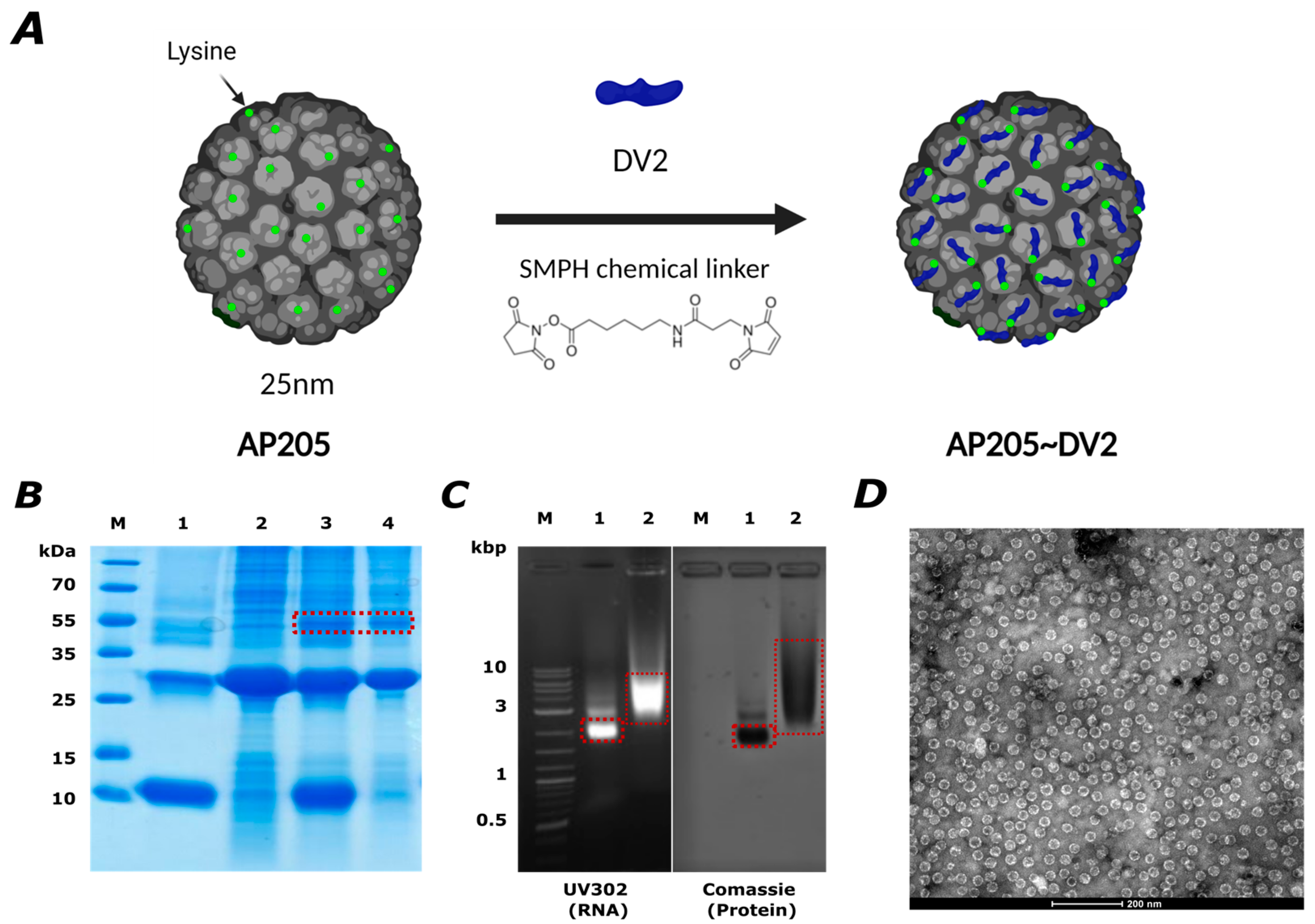


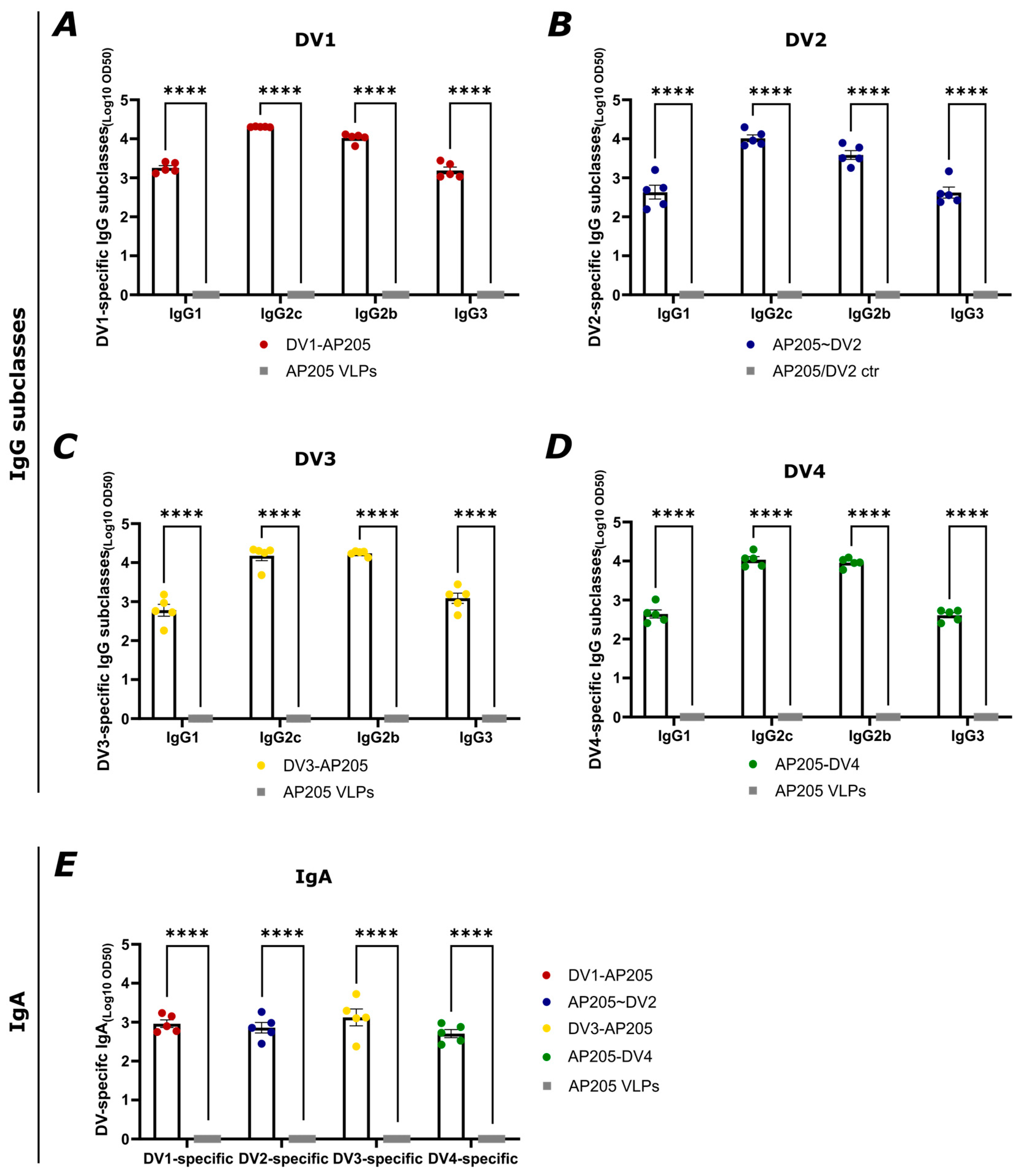
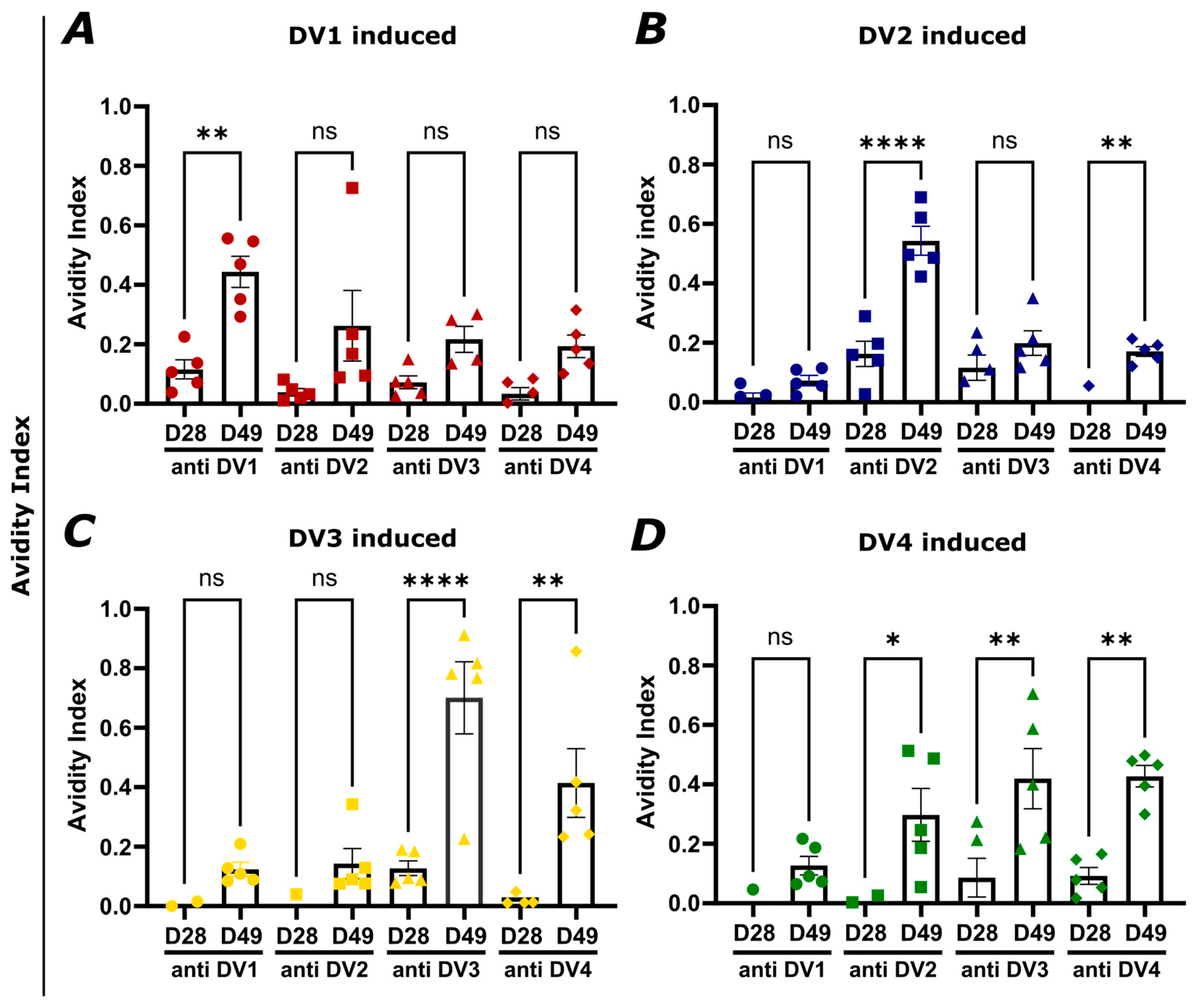
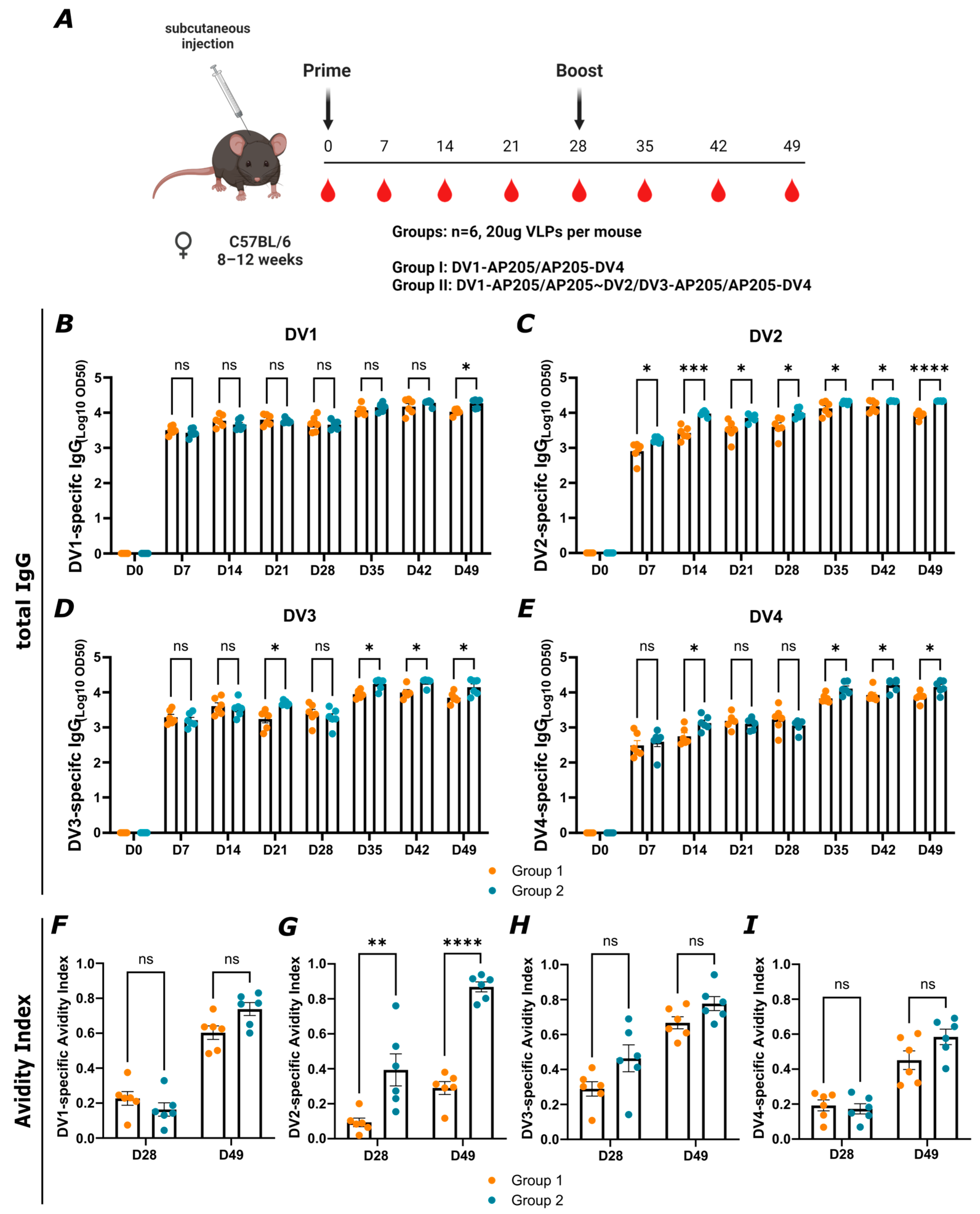

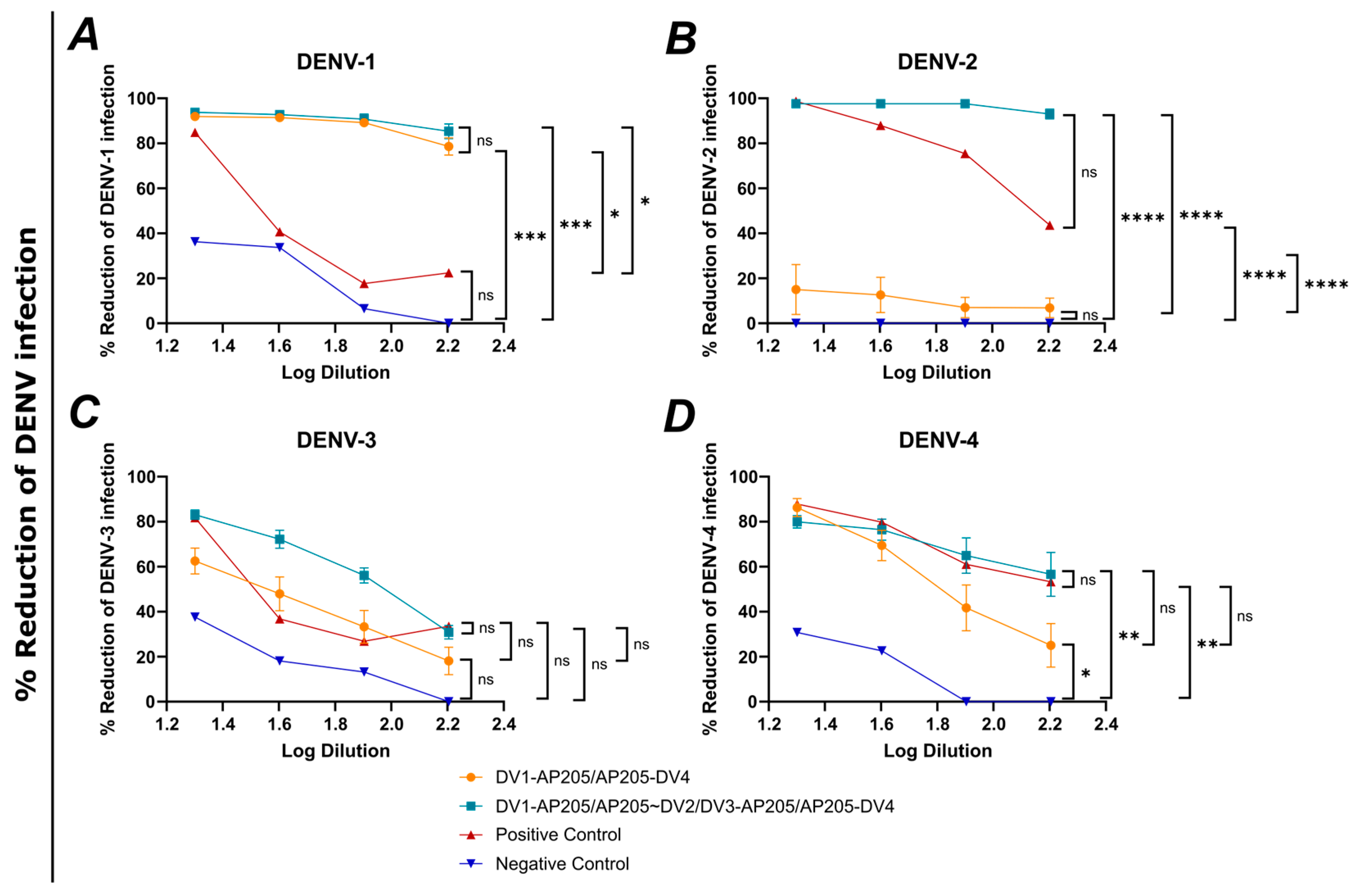
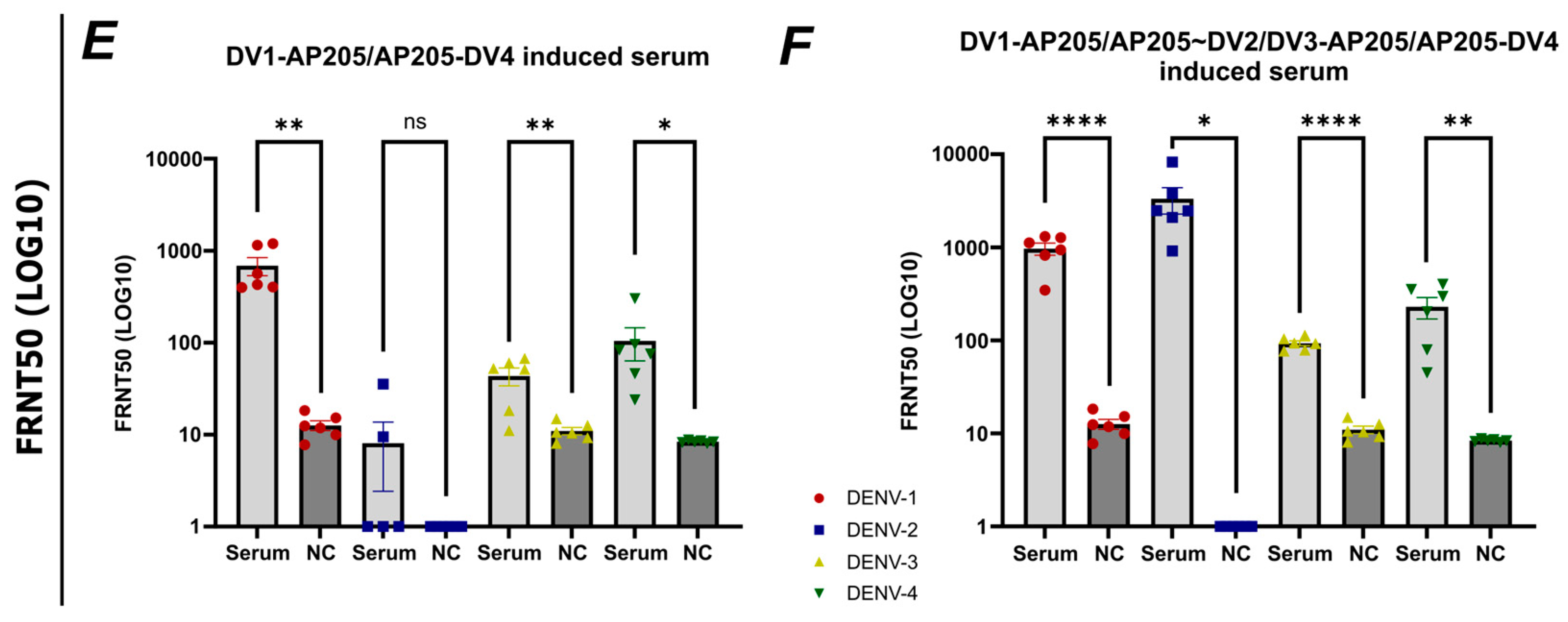
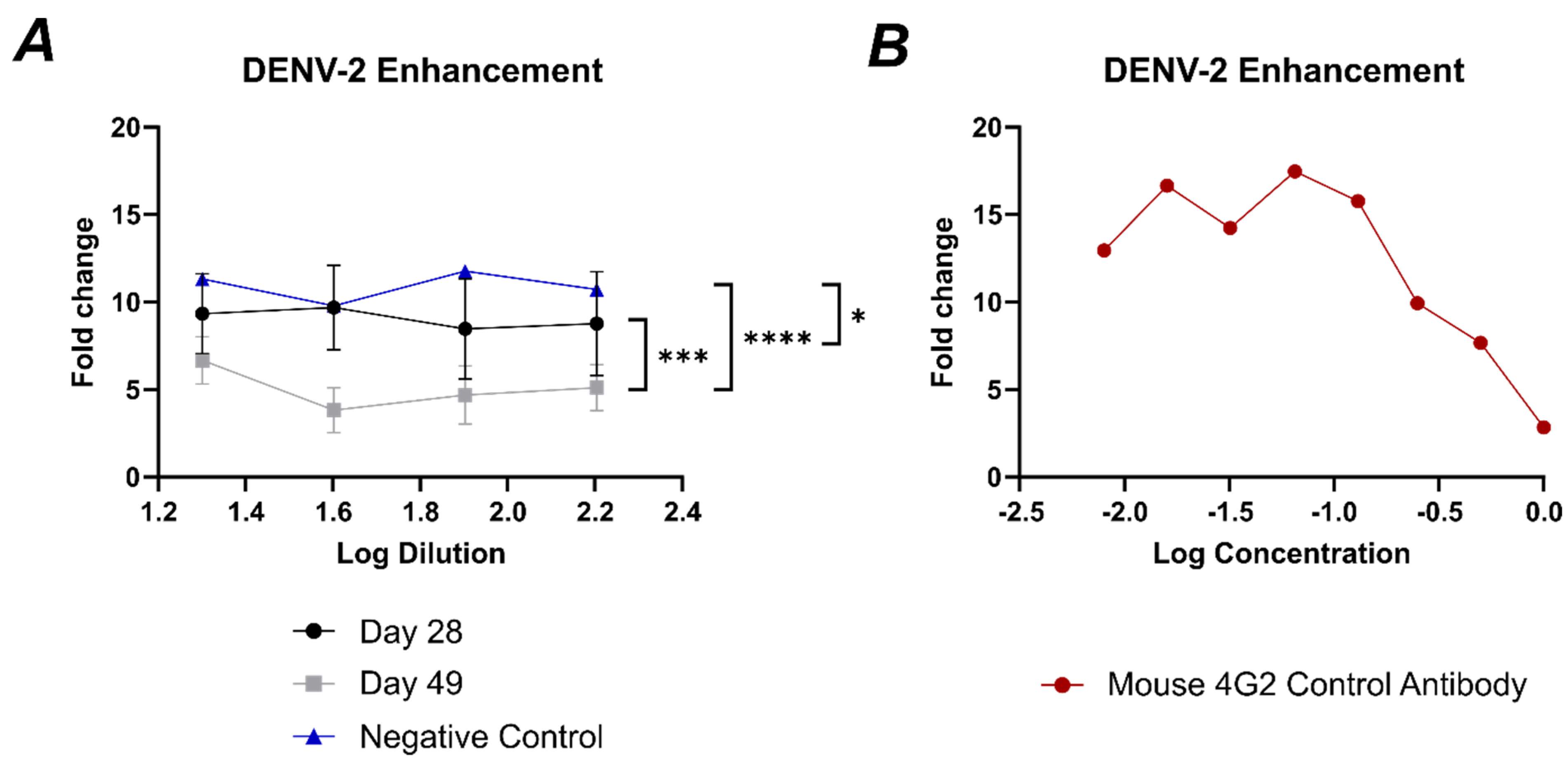
Disclaimer/Publisher’s Note: The statements, opinions and data contained in all publications are solely those of the individual author(s) and contributor(s) and not of MDPI and/or the editor(s). MDPI and/or the editor(s) disclaim responsibility for any injury to people or property resulting from any ideas, methods, instructions or products referred to in the content. |
© 2024 by the authors. Licensee MDPI, Basel, Switzerland. This article is an open access article distributed under the terms and conditions of the Creative Commons Attribution (CC BY) license (https://creativecommons.org/licenses/by/4.0/).
Share and Cite
Rothen, D.A.; Dutta, S.K.; Krenger, P.S.; Vogt, A.-C.S.; Lieknina, I.; Sobczak, J.M.; Osterhaus, A.D.M.E.; Mohsen, M.O.; Vogel, M.; Martina, B.; et al. Preclinical Evaluation of Novel Sterically Optimized VLP-Based Vaccines against All Four DENV Serotypes. Vaccines 2024, 12, 874. https://doi.org/10.3390/vaccines12080874
Rothen DA, Dutta SK, Krenger PS, Vogt A-CS, Lieknina I, Sobczak JM, Osterhaus ADME, Mohsen MO, Vogel M, Martina B, et al. Preclinical Evaluation of Novel Sterically Optimized VLP-Based Vaccines against All Four DENV Serotypes. Vaccines. 2024; 12(8):874. https://doi.org/10.3390/vaccines12080874
Chicago/Turabian StyleRothen, Dominik A., Sudip Kumar Dutta, Pascal S. Krenger, Anne-Cathrine S. Vogt, Ilva Lieknina, Jan M. Sobczak, Albert D. M. E. Osterhaus, Mona O. Mohsen, Monique Vogel, Byron Martina, and et al. 2024. "Preclinical Evaluation of Novel Sterically Optimized VLP-Based Vaccines against All Four DENV Serotypes" Vaccines 12, no. 8: 874. https://doi.org/10.3390/vaccines12080874




